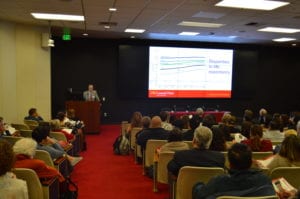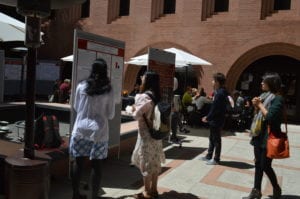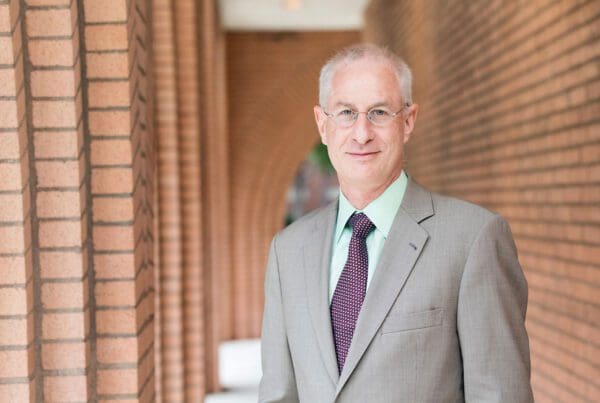
USC Leonard Davis School Dean Pinchas Cohen delivers opening remarks during the 2018 What’s Hot in Aging research at USC conference.
Aging is one of the few truly universal human constants, but this inevitable process isn’t the same for everyone.
Inequalities in lifespan, disease rates, health care access, and more still persist between people of different races, genders, sexual orientation, and socioeconomic status, according to several USC experts who spoke during the 2018 What’s Hot in Aging Research event at the USC Leonard Davis School on April 16.
Accounting for diversity in aging research and moving away from a one-size-fits-all approach to health are key to improving outcomes, said Pinchas Cohen, dean of the USC Leonard Davis School.
“We need to define the opportunities for closing the gaps in healthy aging,” Cohen said.
Biological, environmental, social, and behavioral factors all play roles in health and aging disparities, said Associate Professor Susan Enguidanos, assistant dean for diversity and inclusion at the USC Leonard Davis School.
“We know that there’s a lot of difference in the prevalence of conditions between different cultures,” Enguidanos said. “We see it with diabetes, asthma, hip fracture, hypertension, and cancer, just to name a few. We also know that disease trajectories are different.”
Subtle biological differences provide clues for disease causes, potential treatments
Cohen presented research on how the biology of mitochondria, the energy-producing organelles within cells, and the proteins they express can differ by race—and can have potent effects on age-related health issues.
“While 99.9 percent of the human genome is identical between people of different ethnicities, there are some subtle differences that are uniquely represented in specific ethnicities that represent both an explanation for the frequency of diseases that are more common in certain ethnicities but also a potential approach to both diagnosis and treatment,” he said.
Recent studies have indicated that having higher amounts of certain mitochondria-derived peptides (MDP) expressed by the mitochondrial genome appear to protect against age-related illnesses. One such protein, humanin, is found at lower levels on average in African-Americans, which corresponds with higher prevalence of cancer, cardiovascular disease, and Alzheimer’s. Another mitochondrial protein discovered by the Cohen lab, MOTS-c, appears to mimic the positive effects of exercise but has a variant found in specific Asian populations that lessens its protective benefits.
In mice, administering doses of the normal variants of MDPs appeared to protect against several age-related conditions, and clinical trials testing the proteins as a therapy in humans are slated to begin soon, Cohen said.
“These discoveries related to mitochondrial DNA represent opportunities for us to identify high-risk individuals, target early intervention, implement new therapies, and overcome ethno-specific disparities,” he said.
In addition to genetic differences based on race, another long-overlooked aspect of the aging process is the existence of differences in how men and women age, said Research Professor Todd Morgan of the USC Leonard Davis School. This idea of “sexual dimorphism” in aging is only now being addressed on a larger scale, he explained, with the National Institutes of Health mandating in 1993 that women be included in clinical trials and adding in 2014 that females need to be included in all preclinical trials.
“There are sex differences not only in disease incidence rates between men and women but also differences in disease symptoms and in the age of disease onset,” Morgan said.
One major difference between the sexes: women are much more likely to get Alzheimer’s disease. One reason for this susceptibility may be due to the precipitous drop in sex steroid hormones women experience during menopause, while hormone decreases are much more gradual in older men. Studies at the USC Leonard Davis School have shown that removing sex steroids can increase the amount of Alzheimer’s-like pathology in the brain, Morgan explained.
While previous research on addressing the issue with hormone replacement therapy (HRT) well after menopause didn’t many have promising results, a USC study, the Early Versus Late Intervention Trial With Estradiol (ELITE), is investigating whether administering HRT soon after menopause provides protection against the disease’s pathology. Preliminary results suggest that HRT, if administered during a “critical window” shortly after menopause, could slow progression of Alzheimer’s pathology, Morgan said.

Students presented research posters during the 2018 What’s Hot in Aging Research at USC conference.
Varying needs, beliefs, and barriers call for more thoughtful interventions
Beyond nuances of biology, difference in aging outcomes between populations can often be traced to social characteristics and barriers, according to several conference presenters.
Older members of the lesbian, gay, bisexual and transgender (LGBT) community have several concerns related to accessing care and housing as they age, said Julie Bates, a USC Leonard Davis School lecturer and associate state director of AARP California.
The results of AARP’s “Maintaining Dignity: a Survey of LGBT Adults Age 45-plus” show that many older LGBT individuals are concerned with not having support and potentially facing discrimination as they try to navigate housing and services as they age. More than 80 percent of respondents said they’d like to find more long-term care services designed to be LGBT-friendly; 88 percent said they’d like to find providers who’ve received training regarding LGBT concerns.
“Thirty-four percent of LGBT adults are concerned that they’ll have to hide their identity in order to access suitable housing as they age. Sixty percent are concerned about possible verbal or physical harassment in long-term care,” Bates said. She added that African-American and Latino LGBT individuals have compounded discrimination concerns about the quality of their healthcare as they age based on both race and LGBT identity.
Another factor in health care outcomes, especially for those facing serious or terminal illness, is whether an individual has completed an advanced directive. This legal document outlines health care preferences and designates who should make medical decisions for a patient should the patient become incapacitated. However, advanced directive completion rates have varied by race and ethnicity, even though the documents can help improve care for all patients, said PhD in Gerontology candidate Catherine Pérez.
“At any age, a medical crisis could leave you too ill to make health care decisions,” she warned. “Ideally, everyone should have an advanced directive because research has shown it is associated with improved quality of care at end of life.”
Research has shown that African-American and Hispanic people are still less likely than whites to have completed an advanced directive, even as advanced directive completion rates have risen among minority groups in recent decades. Beliefs about end-of-life care may play a role in why the gap persists, even among individuals of higher socioeconomic status, Pérez said. For instance, African Americans—among whom only 20 percent of individuals over 50 report completing an advanced directive—are more likely to report fearing that an advanced directive will lead to them receiving lower-quality care. Hispanics more frequently report not feeling the need to complete an advanced directive because they assume family members will step up to make decisions; about a third of older Hispanic individuals over 50 had completed advanced directives in 2014.
Beliefs also affect how African-American caregivers in Los Angeles perceive themselves as well as what kinds of support they look for, said USC Leonard Davis Research Associate Professor Donna Benton, director of the USC Family Caregiver Support Center.
“It becomes difficult to target services to this community because no one calls themselves ‘caregivers,’” Benton said, explaining that caregiving is simply viewed as the right thing to do for a family member. “They’ll call us on behalf of their family members, and we have to convince them they’re caregivers.”
Benton added that designing supports for this community of caregivers required fighting mistrust, making programs culturally relevant, and determining community-defined practices. “The people you want to serve can tell you what they need,” she said.
Benton cited a recent example of this process in practice at First AME Church in Los Angeles. Instead of asking caregivers to come directly to the Family Caregiver Support Center, the center worked with a church member, Bobbe Akalonu, in training members of the women’s missionary group to provide outreach and run a successful support group for caregivers in their church.
The interconnectedness of environment, health, and social factors
Where you live can also have a big effect on how you age, and environmental inequality is inextricably intertwined with health and social inequality, said USC Leonard Davis Assistant Professor Jennifer Ailshire.
“People live in different places, and there’s inequality embedded in the experience of one’s neighborhood,” she said. Living in neighborhoods with high levels of poverty, air pollution, and disorder or neglect is correlated with poorer health outcomes for older adults; recent USC research has connected living in high-pollution neighborhoods with higher rates of cognitive decline. However, the rates of people living in neighborhoods with such stressors and risks vary greatly based on socioeconomic status and race/ethnicity, with African-American and Hispanic individuals being more likely in poor, polluted, or neglected neighborhoods.
“Older black households at the highest income level are still more likely to live in high poverty neighborhoods than whites at the lowest income level,” Ailshire cited. “This is a legacy of redlining and race residential segregation that has endured over the life course.”
This convergence of decades of inequality with a doubling of the older adult population should shape the conversation about making communities more age-friendly, she added.
“We really need to think about how we can create age-friendly and healthy spaces not just for older adults but for all older adults, including those who are more socially vulnerable due to these long-stretching processes of inequality,” Ailshire said.
Resident service coordinators—who bring services and support directly to older adults in U.S. Department of Housing and Urban Development (HUD)-assisted housing—help promote safe and healthy home environments for low-income seniors of many different backgrounds, said Tameka Brown MAG ’12, USC Leonard Davis School instructor and resident services supervisor for HumanGood, and Luis Perez, senior lead resident services coordinator with TELACU Residential Management.
Within HUD-assisted housing, resident service coordinators help provide physical and financial security, connect residents to community-based support services, and promote healthy social connections. From helping residents navigate unexpected costs to helping neighbors work through disputes, resident service coordinators wear many hats, Brown said.
“Resident service coordinators provide referrals, services, programming, activities, and education,” she said, adding that service coordinators preserve independence and save money by reducing the need for older adults to move from their homes into assisted living or skilled nursing facilities.
Along with avoiding premature institutionalization and providing 360-degree cost savings, Perez said research has shown that resident service coordinator programs correlate with an 18 percent reduction in hospital admission rates in communities where they operate.
“We help residents live fully and independently for as long as possible,” he said.





